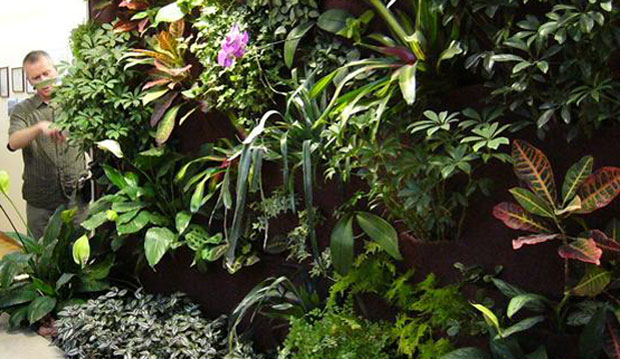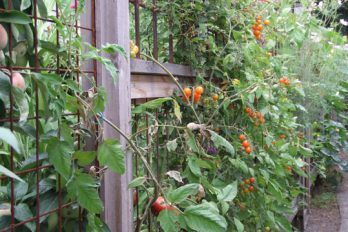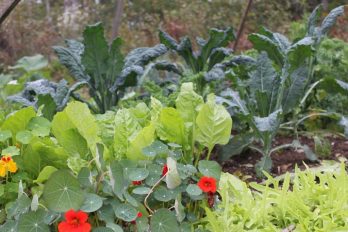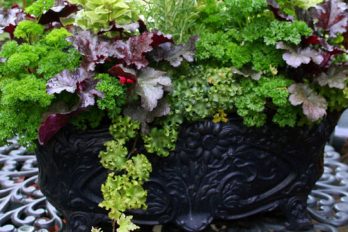Remember when builders touted airtight buildings as a good thing? Now that we’re all cozily sealed up, we’ve learned that insufficient ventilation is responsible for nasty things such as encouraging mould and creating a breeding ground for contaminants. Gases (known as “volatile organic compounds”) from synthetic fibres, carpet glue, foam, paints, plastics, household appliances, electronic equipment and sundry other items are released into the air and have nowhere to go.
The result is sick building syndrome – that hard-to-pinpoint problem defined by symptoms such as fatigue, burning eyes, headache, dry cough and itchy skin. Scientists around the world have been working on this puzzle for decades. They have even come up with a word to describe their research – Baubiologie – a term coined at the Institute für Baubiologie und Ökologie in Neubeuern, Germany, and used to mean “how buildings impact life”.
One of the many outcomes of this research is the use of plants to filter the air by installing “biofilter walls”, “living walls” or “green walls”. Call them what you will, they’re basically walls covered in plants that absorb airborne contaminants (such as formaldehyde, toluene, benzene and trichloroethylene) and deliver them to the beneficial microbes that reside in their roots. The microbes break down the toxins and convert them into water and carbon dioxide.
The bones of the wall are usually made of a synthetic polyester weave and the plants are watered using vertical hydroponics (water from a reservoir is pumped up to the plants). To be an effective filter, the general rule of thumb for a typical office space is that you need one square metre of biowall for every 100 square metres of floor space. If, however, you were installing a biowall in something like a paint factory, you would have to change the ratio to deal with the higher level of contaminants that would likely be in the air. Plant walls have been around for a long time as an aesthetic element, but a true biowall must be integrated with the building’s air conditioning, heating and filtration systems.
Plants are chosen according to their ability to thrive in the particular building (with its unique lighting and temperature extremes) and in a vertical space. The really good news for Canadians is that the plants most often used are tropical ones (which also increase humidity levels) such as orchids, fuchsia and hibiscus – plants that we generally lust after only in our hearts.
Not surprisingly, there is much dissension among the emerging experts, particularly as it relates to plant choices, growing medium and the variety of elements that are necessary to replicate an ecosystem. Some say that any plants used (other than those on the ground) should be epiphytes (air plants) because no growing medium can maintain sufficient nutrients to offer continuing support to terrestrial plants. Others disagree. Some insist that plants be totally washed of their original soil before being installed; others think it’s unnecessary. Does a biofilter need a complete ecosystem, including fish, frogs and all manner of creatures to function properly? Yes, or, no – you see the problem.
The experts, however, do agree on a few things. Biofilter walls are not as expensive as they sound, and they pay for themselves quickly by significantly reducing demands on air conditioning and heating systems. Preliminary tests show that buildings with biowalls have air that is as clean as outside air. Some might question whether this is an improvement, but studies by the United States Environmental Protection Agency show that indoor air is often ten times worse than outside air.
A lot of companies are getting on the biowall bandwagon, and there is an unseemly rush internationally to trademark some of the terms used to define these walls. This considerably muddies the waters, as the terms are often used to describe very different things. “Breathing wall”, for example, can be used to describe walls made of a wide variety of materials, with or without the addition of plants.
So far, most of the buildings in Canada using this technology are commercial and public ones. The University of Guelph, with research funding from the Ontario Ministry of Agriculture, Food and Rural Affairs as well as other private and public sponsors, has installed a four-storey biofilter wall in the $45-million Guelph-Humber building on Humber College’s north campus in Toronto. Last year, the Royal Architectural Institute of Canada awarded the building and its architects, Diamond and Schmitt Architects Inc./RHL Architects, a medal for innovation in architecture. Other Ontario universities, including Queen’s, the University of Waterloo and the University of Toronto, are now installing biofilter walls of their own.
Commercial buildings are getting on board too. In 2002, new owners decided to restore the Robertson Building, a historic Edwardian factory/warehouse at 215 Spadina Avenue (at Queen) in Toronto. They added a green roof and, in the lobby, a biofilter wall. When you enter the building, you realize another advantage of the technology – the lobby smells good! Let’s face it, most old office buildings smell like a combination of old socks and despair, but this one smells leafy, fresh and, overall, pretty wonderful. It’s not quite as amazing as your garden smells after a gentle summer rain, but it’s pretty darn close! How good is that for a country that spends so many months covered in snow?
Don’t rush out to get yourself a biofilter wall just yet; there’s research to be done before the walls are practical and cost-efficient for residential use. But you may want to think before throwing out that tatty poinsettia; it may not be the looker it once was, but it’s still working hard to absorb the formaldehyde produced by a number of common household cleaners.





Comments are closed.